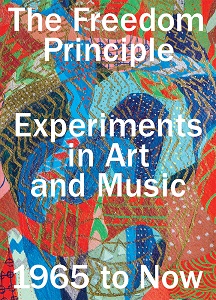The Freedom Principle
This past weekend, the Museum of Contemporary Art Chicago launched the exhibition The Freedom Principle: Experiments in Art and Music, 1965 to Now, co-organized by Naomi Beckwith and Dieter Roelstraete. An easy explication for the impetus behind the show takes the viewer to the South Side of Chicago in the 1960s, where African American artists and musicians grappled with new language and forms inspired by the black nationalist turn in the Civil Rights movement. I’m plucking that line from the jacket copy, but the show (and its associated book) goes beyond [its important] cultural inventory and instead repositions the wide-ranging experimental works and the community of artists who made them in one particular canon to which they have long-belonged: the history of avant-garde collectives engaged equally in art and social justice.
You can view sample pages from the book here.
From a very brief description via the Art Newspaper:
This year, the Association for the Advancement of Creative Musicians (AACM), an avant-garde jazz collective founded on the South Side of Chicago, celebrates its 50th birthday. Chicago’s Museum of Contemporary Art is joining the festivities with the exhibition The Freedom Principle: Experiments in Art and Music, 1965 to Now. Hingeing on the themes of improvisation, experimentation and collectivity, it looks at the 1960s avant-garde African-American arts scene of the South Side, including the AACM and visual art collectives such as the African Commune of Bad Relevant Artists (AfriCOBRA) and art that responds to and continues this legacy.
And from a more fleshed-out version at the MCA Chicago’s website:
The exhibition, which takes its title from a 1984 book by Chicago jazz critic John Litweiler, showcases the multifaceted world of the black avant-garde in Chicago during the 1960s alongside a selection of contemporary artists’ interpretations of this heritage. It includes works of music and art from, among others, AACM-founder, pianist, and painter Muhal Richard Abrams; Art Ensemble of Chicago bandleader Roscoe Mitchell; and AfriCOBRA cofounders Jeff Donaldson, Jae and Wadsworth Jarrell, Barbara Jones-Hogu, and Gerald Williams. Archival materials—brochures, banners, photographs, posters, sheet music, record covers—provide a rich context for the exhibition. Recent works by artists such as Terry Adkins, Nick Cave, Renée Green, Rashid Johnson, Lili Reynaud-Dewar, Cauleen Smith, and Stan Douglas present an ongoing intergenerational conversation about experimentation, improvisation, collective action, and the search for freedom. Working together across multiple platforms, Catherine Sullivan, George Lewis, Charles Gaines, and Sean Griffin are collaborating on an opera, to be presented on the MCA Stage, and on a related installation within the exhibition.
Long story, short: the sample pages are tantalizing, because the show is quite stunning in its breadth and depth. If the art, images, marginalia, and artifacts gathered here don’t immediately grab you, then, I just don’t know. You should go back and read George E. Lewis’s communal history, A Power Stronger than Itself: The AACM and American Experimental Music? And then think to yourself: I wonder how this looked. And felt. And how it worked. And what it all means now.
Read more about The Freedom Principle here.
